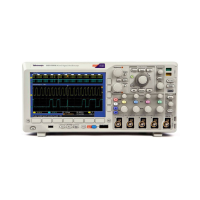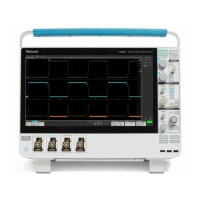Trigger Setup
I
2
C, SPI, CAN, and LIN, and FlexRay Bus Trigger Data Matching
Rolling window byte matching for I
2
C, SPI, and FlexRay. To use a rolling window to trigger on data, you define
the number of bytes to match. Then the oscilloscope uses a rolling window to find any match within a packet, with the
window rolling one byte at a time.
For example, if the number of bytes is one, th e oscilloscope will attempt to match the first byte, second byte, third, and so
on within the packet.
If the number of bytes is two, the oscilloscope will try to m atch any two consecutive bytes, such as one and two, two and
three, three and four, and so on. If the oscilloscope finds a m atch, it will trigger.
With FlexRay, obtain a rolling w indow match by setting the Byte Offset in the Data m enu to Don't care.
Specific byte matching (non-rolling window matching for a specific position in the packet) for I
2
C, SPI,
CAN, LIN, and FlexRay.
You can trigger on a specificbyteforI
2
C, SPI, CAN, LIN, and FlexRay in several ways:
For I
2
C and SPI, enter the number of bytes to m atch the number of bytes in the signal. Then use don't cares (X) to
mask the by
tes that you are not interested in.
For I
2
C, pu
sh Trigger On on the lower menu to trigger on Address/Data. Push Address . On the side menu, push
Address, and rotate multipurpose knobs a and b as needed. Set the address to don't cares (X) if you want to mask the
address. The data will be matched starting at the first byte without using a rolling w indow.
For CAN and LIN, triggering occurs when the user-selected data input matches the data and qualifier in the signal
starting
at the first byte. Set the number of bytes to match the number of bytes of interest. Use the data qualifier to
perform: =, !=, <, >, >=, and <= operations. Triggering on identifier and data always matches the identifier and data
selected by the user, with the data starting at the first byte. No rolling window is used.
For F lexRay, triggering occurs when the user-selected data input matches the data and qualifier in the signal starting at
the byte
offset. Set the number of bytes to match the number of bytes of interest. Use the data qualifier to perform: =,
!=, <, >, >=, and <= operations. Triggering on identifier and data always matches the identifier and data selected by
the user, w ith the data starting at the first b yte. No rolling window is used.
Data Va
lue Matching
You can trigger on a specific data value for RS-232 bytes. If you defined an end-of-packet character to use for RS-232 bus
decoding, you can use the same end-of-packet character as a data value for trigger data matching. To do so, choose the Tx
End of Packet or the Rx End of Packet character as the Trigger On selection.
You can also trigger on a specific data value for other buses.
ParallelBusTriggerDataMatching
Optimum parallel bus trigger performance is achieved by using only analog channels or only digital channels
(MS
O3000 Series only).
80 MSO3000 and DP O3000 Series Oscilloscopes User Manual

